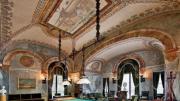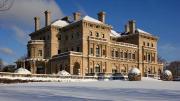As winds whip off the Atlantic Ocean and waves crash along Newport’s famous Cliff Walk outside, visitors on the “Beneath The Breakers” tour meander through the labyrinthine bowels of the Vanderbilt family’s Gilded Age mansion.
The tour covers the development of modern electricity and plumbing, which ran throughout the five-story, 70-room Italian Renaissance-style palazzo. It also explores the hand-dug boiler room, where two massive units once burned as much as 250 tons of coal a year. “But these are summer homes, why did they need heat?” Raymond Roy, a guide with The Preservation Society of Newport County, asks, then explains: the 5,000 feet of water pipes snaking through 20 bathrooms could freeze. “From October 1 to May 1, there were men working in the boiler room around the clock, even though the family wasn’t here.”
The depopulated winter season also offers contemporary Newport visitors a far quieter and often more intimate look at The Breakers, and at the three other estates owned and opened year-round by the preservation society: The Elms, Marble House, and Rosecliff (where “Pierre Cardin: 70 Years of Innovation” offers 42 original outfits from the designer’s private archives through February 28). “We don’t really want to grow a lot more in the summer, when the city is very, very crowded,” says John G. Rodman, M.P.A. ’93, director of museum experience for the society’s 11 properties, which draw more than one million admissions a year. “This allows people to see the homes in a different way.”
With those properties open, Rodman adds, more of the city’s restaurants have added winter hours, especially in conjunction with the annual Newport Winter Festival (February 16-25). The event—packed with magic shows, concerts, and children’s activities, along with fêtes featuring food and drinks—traditionally culminates in the popular polo exhibition on Easton Beach. Also open during the winter are the International Tennis Hall of Fame (worth a stop even if you’re not an avid fan of the sport), and the Newport Art Museum, where the photography shows “Lissa Rivera: Beautiful Boy” and “Domestic Affairs: Domesticity, Identity, and the Home” open on January 20. Food and drinks abound. The lively Brick Alley Pub has terrific comfort fare, or try the funkier Salvation Café; for a more refined dining option, head to the stylish new Stoneacre Brasserie.
The summertime hubbub and pervasive wharf-side tourist trade can also overwhelm Newport’s elemental natural beauty. If the weather holds, suit up and get out on the three-mile Cliff Walk and exult in the salty sprays and bracing chill of New England’s iconic coastal clime.












